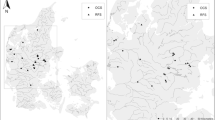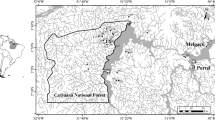Summary
Data on long-term research on the ecology of Central Amazonian forest streams are presented and they reveal the following basic features: Firstly, the essential input of nutrients into these waters consists of forest litter and of the fungi that decompose this litter; consequently, the bulk of the fauna is concentrated in accumulations of submerged litter. Secondly, the nutrients released by the decomposition of this litter do not appear in solution in the stream water, but are tied up throughout in the food web of the aquatic fauna. Thirdly, this food web is relatively robust. This is due to the absence of food specialists in the major channels of energy transfer. One of the staple foods for invertebrate predators consists of chironomid larvae. Fourthly, the degree of acidity and/or the content of dissolved humic substances (more or less black water) has a marked effect on the density and to a lesser extent on the species diversity of the invertebrate fauna, black waters being richer in both. Fifthly, the annual inundations of the forest in the middle and lower courses of the smaller rivers lead to drastic periodic changes of animal densities, and in some cases to annual periodicity of breeding, as exemplified by a three-year study of shrimp populations in the river ‘Tarumazinho’.
Similar content being viewed by others
References
Adis, J., Furch, K., and Irmler, U., Litter production of a Central Amazonian black water inundation forest. Trop. Ecol.20 (1979) 236–245.
Baerlocher, F., and Kendrick, B., Role of aquatic Hyphomycetes in the trophic structure of streams, in: The Fungal Community. Eds D. T. Wicklow and G. C. Carroll. Marcel Dekker, New York 1981.
Benchimol, S., Amazônia, um pouco-antes e além-depois. Editora Umberto Calderaro, Manaus 1977.
Chauvel, A., Lucas, Y., and Boulet, R., On the genesis of the soil mantle of the region of Manaus, Central Amazonia, Brazil. Experientia43 (1987) 234–241.
Cummins, K. W., Structure and function of stream ecosystems. Bioscience24 (1974) 631–641.
Documenta Geigy, Wissenschaftliche Tabellen. Basel 1963.
Fittkau, E. J., Irmler, U., Junk, W. J., Reiss, F., and Schmidt, G. W., Productivity, biomass and population dynamics in Amazonian water bodies, in: Tropical Ecological Systems. Eds F. B. Golley and E. Medina. Springer, Heidelberg/New York 1975.
Hardy, E. R., Composição do Zooplacton em cinco lagos da Amazônia Central. Acta amazon.10 (1980) 577–610.
Henderson, P. A., and Walker, I., On the leaf litter community of the amazonian black water stream Tarumãzinho. J. trop. Ecol.2 (1986) 1–17.
Irmler, U., Ecological studies of the aquatic soil invertebrates in three inundation forests of Central Amazônia. Amazoniana5 (1975) 339–406.
Janzen, D. H., Tropical black water rivers; animals and mast fruiting by the Dipterocarpaceae. Biotropica6 (1974) 69–103.
Junk, W. J., As águas da região Amazônica, in: Amazonia, Desenvolvimento, Integração, Ecologia, Eds E. Salati, H. O. R. Schubart and W. Junk. CNPq editora brasiliense 1983.
Kensley, B., and Walker, I., Palaemonid shrimps from the Amazon Basin, Brasil (Crustacea: Decapoda: Natantia). Smithsonian Contributions to Zoology362 (1982) 1–28.
Klinge, H., Fine litter production and nutrient return to the soil in three natural forest stands of Eastern Amazônia. Geol. Trop.1 (1977) 159–167.
Klinge, H., and Rodrigues, W., Litter production in an area of Amazonian terra firme forest. Part 1: litter fall, organic Carbon and total nitrogen contents of litter. Amazoniana1 (1968) 287–302.
Knöppel, H. A., Food of Central Amazonian fishes. Contribution to the nutrient ecology of Amazonian rain forest streams. Amazoniana2 (1970) 257–352.
Leenheer, J. A., Origin and nature of humic substances in the waters of the Amazon River Basin. Acta amazon.10 (1980) 513–526.
Leenheer, J. A., Personal communication based on the analyses of the data cited above.
Luizão, F. J., Produção e decomposição da liteira em floresta de terra firme da Amazonia Central. Aspectos químicos e biológicos da lixiviação e remoção dos nutrientes da liteira. Tese de Mestrado. INPA/ FUA, Manaus 1982.
Padgett, D. Ee., Leaf decomposition by fungi in a tropical rain forest stream. Biotropica8 (1976) 166–178.
Petrere, M. Jr, Pesca e esforço de pesca no Estado do Amazonas, Tese de mestrado. INPA/FUA, Manaus 1977.
Rai, H., and Hill, G., Classification of Central Amazon lakes on the basis of their microbiological and physicochemical characteristics. Hydrobiologia72 (1980) 85–99.
Schmidt, G. W., Chemical properties of some waters in the tropical rain forest region of Central Amazônia. Amazoniana3 (1972) 199–207.
Sioli, H., Gewässerchemie und Vorgänge in den Böden im Amazonasgebiet. Naturwissenschaften41 (1954) 456–457.
Sioli, H., Tropical rivers: the Amazon, in: River Ecology. Ed. B. A. Whitton. University of California Press, Berkeley and Los Angeles 1975.
Ungemach, H., Die Ionenfracht des Rio Negro, Staat Amazonas, Brasilien. Amazoniana3 (1972) 175–185.
Ungemach, H., Regenwasseranalysen aus Zentralamazonien, ausgeführt in Manaus, Amazonas, Brasilien. Amazoniana3 (1972) 186–198.
Walker, I., Rede de alimentação de invertebrados das águas pretas do sistema Rio Negro. 1. Observações sobre a predação de uma ameba do tipoAmoeba discoides. Acta amazon.8 (1978) 423–438.
Walker, I., The Thecamoebae (Protozoa, Rhizopoda) of small Amazonian forest streams and their possible use as indicator organisms for water quality. Acta amazon.12 (1982) 79–105.
Walker, I., On the structure and ecology of the micro-fauna in the Central Amazonian forest stream “Igarapé da Cachoeira”. Hydrobiologia122 (1985) 137–152.
Walker, I., and Lages, M. T., Adaptation of constant-effort sampling and of removal trapping for the estimation of microscopic organisms in dense substrates. Acta amazon.10 (1980) 535–544.
Walker, I., and Ferreira, M. J. N., On the population dynamics and ecology of the shrimp species (Crustacea, Decapoda, Natantia) in the Central Amazonian river Tarumãzinho. Oecologia66 (1985) 264–270.
Walker, I., and Franken, W., Ecossitemas frágeis: a floresta da terra firme da Amazônia Central. Ciênc. Interam.23 (1983) 9–21.
Author information
Authors and Affiliations
Rights and permissions
About this article
Cite this article
Walker, I. The biology of streams as part of Amazonian forest ecology. Experientia 43, 279–287 (1987). https://doi.org/10.1007/BF01945551
Published:
Issue Date:
DOI: https://doi.org/10.1007/BF01945551




